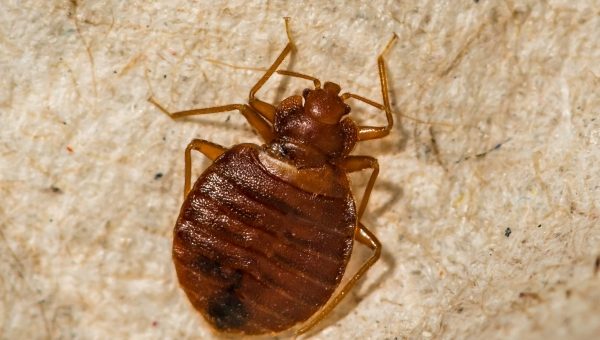17
Oct
Paris’s Worrying Bed Bug Surge Linked to Insecticide-Resistance

(Beyond Pesticides, October 17, 2023) In the past month, Paris, France has witnessed a surge in bed bug populations. From public transportation to hotels, hostels, and movie theatres, bed bugs are posing a threat to the city’s two million residents and potentially a broader global population as the infestation spreads.
This resurgence of bed bugs in Paris is not unique. For centuries, these pests have been both adaptable and persistent, presenting an enduring challenge to pest control. However, the current surge in bed bug infestations is not merely a revival of a longstanding problem; it is a complex issue intertwined with the development of resistance to insecticides, mainly through a mechanism known as knockdown resistance. This mechanism, along with three other main resistance mechanisms, has enabled these insects to defy chemical-intensive control methods
Knockdown resistance is a significant factor contributing to the resistance exhibited by bed bugs to insecticides, especially pyrethroids. The mechanism plays a central role in countering the action of these insecticides, which target the nervous system of bed bugs, causing paralysis and eventual death. Knockdown resistance provides the genetic adaptation that provides bed bug populations with resistance to insecticides. It inhibits the effectiveness of certain insecticides. Bed bugs with the mutation have a genetic advantage that allows them to survive exposure to these chemicals.
Insecticide has been utilized to quell bed bug populations for over a century, with DDT initially used to combat these pests before the 1950s. By 1956, the effectiveness of DDT in controlling bed bug populations began to diminish, as the insects developed resistance to the once-potent chemical. The repetitive exposure of bed bugs to DDT led to the survival of bed bugs with genetic mutations that allowed them to survive DDT exposure, giving rise to newer generations with the same mutations.
The banning of DDT in 1972 compelled the United States to turn to organophosphates and, more recently, the commonly used pyrethroids–synthetic insecticides widely used for residential pests. However, there was an unforeseen consequence of DDT resistance: bed bugs with DDT resistance demonstrated resistance to other pesticides, including pyrethroids, even if they had never encountered pyrethroids. This phenomenon, known as cross-resistance, paved the way for a global resurgence of bed bugs and posed challenges for pest control worldwide.
Knockdown resistance is linked to the voltage-gated sodium channels (VGSC) within a bed bug’s nervous system. These channels serve as conduits for transmitting electrical signals, enabling nerve cells to communicate and control the bug’s movements. Knockdown resistance arises from mutations within the VGSC gene.
Scientists have identified three specific mutations in the common bed bug, Cimex lectularius: V419L, L925I, and 1936F. In modifying the function of sodium channels, these mutations make the insect less responsive to the effects of pyrethroid insecticides. As a result, the nerve cells of resistant bed bugs can continue to function despite exposure to these chemicals.
Research has revealed that knockdown resistance is prevalent in bed bug populations, particularly those closely linked to human environments. Most bed bug populations associated with human environments exhibit the L925I mutation, which equips them with resistance to pyrethroids.
This widespread distribution of knockdown resistance raises concerns about the continued use and efficacy of pyrethroids in treating infestations. Bed bugs with knockdown mutations possess the capacity to withstand exposure to insecticides, reducing the effectiveness of these treatments. As a result, infestations persist, inflicting discomfort, economic burdens, and health concerns upon those affected.
Moreover, the insecticide resistance exhibited by bed bugs extends into other classes of insecticides. The developing resistance of bed bugs to neonicotinoid insecticides raises similar questions about chemical-dependent control strategies for infestations. Research has found that neonicotinoids, once thought by the pest control industry to be the silver bullet solution for bed bug infestations, are losing their efficacy as bed bugs from different regions are becoming resistant to them.
In a study led by Alvaro Romero, PhD, and Troy Anderson, PhD, bed bugs collected from homes in Cincinnati and Michigan were exposed to four different neonicotinoids: acetamiprid, dinotefuran, imidacloprid, and thiamethoxam. The study also tested these neonicotinoids on bed bugs that had never been exposed to insecticides.
They found that bed bugs previously exposed to neonicotinoids show higher levels of resistance to these insecticides. This resistance was elevated when compared to the levels of resistance exhibited by the bed bugs that had never been exposed to the neonicotinoids. It took over a thousand times more acetamiprid to kill half of the bed bug population with prior exposure to neonicotinoids, as opposed to the population that had never been exposed to neonicotinoids. This means the bed bugs in the Michigan and Cincinnati study proved to be hundreds or even thousands of times more resistant to neonicotinoids compared to the lab control group.
As insecticide usage continues in response to growing issues of invasive species migration and insect infestations, the infestation problem will only grow worse. The situation in Paris is just one example of what is to come if pesticide dependency continues. The best method for handling infestations is by skipping the chemicals and following a defined integrated pest management system that prioritizes ecologically balanced solutions, and only allows organic-compatible products.
Beyond Pesticides is committed to providing organic pest management solutions—including treatments for bed bugs–that hold health and environment central. If you find yourself dealing with a bed bug infestation, please visit the Beyond Pesticides webpage to access the ManageSafe Database, which offers the least-toxic control of pests. Also see our Bed Bug webpage, Bed Bugs in Public Housing guide, and other resources.
All unattributed positions and opinions in this piece are those of Beyond Pesticides.
Source: Ohio State University, Insecticide Resistance Research











This means we are to reduce Pesticide use and remove the furniture, carpet, bed mattress, etc and usne less chemicals to spot treat crack and crevices near the items removed.
October 25th, 2023 at 9:00 amThis also causes less cancer, less nerve damage, and a Cleaner water and air system.